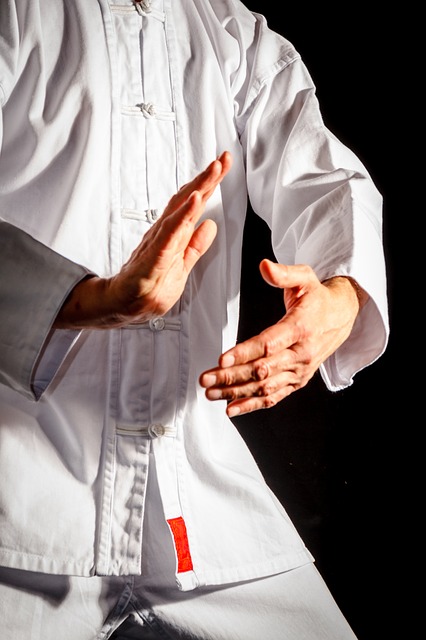
You’ve probably seen groups of people out in a park, making slow graceful movements with their arms in time with each other. Stepping slowing in one direction, and then another – poised balanced. What is this beautiful choreography, this slow motion dance they are performing? Is it Tai Chi, or is it Qigong?
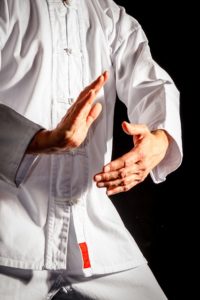
On the surface there are a lot of similarities so it is understandable that people are often curious about the difference between these arts. This article will provide an overview of some of the key differences and similarities between Tai Chi and qigong, including history, principles, benefits and application, and make some suggestions about which one you might be best for you to do.
Spelling and definition of Tai Chi and Qigong
We’ll start with the simple definition and spelling of the words commonly used to label these arts. There may be a little more to this than you would first expect. You see there are two different systems for anglicizing Chinese that are commonly used (as well as many more ad hoc phonetic transliterations that individual authors come up with that you may see from time to time). The first of these is the Wade-Giles system which was popularly used for most of the 20th century, and Pinyin which was introduced in 1958, but took quite a long time to become popular. Pinyin is now the official way to romanize Chinese words, so most modern texts will use this method, but the transition between the two has been gradual, so many older texts, and even a very few modern ones will still use the Wade-Giles system.
In the Wade-Giles system the respective spellings are Tai Chi and Chi Kung. In Pinyin they are Taiji and Qigong. You will notice that in this article, other than in this section on spelling, I will be using the Wade-Giles spelling for Tai Chi, and the Pinyin spelling for Qigong. This is due to a little historical quirk where Tai Chi started to become recognized in the western world at a time when the Wade-Giles system was commonly used. So the spelling ‘Tai Chi’ has become so commonly used that this is much easier for people to recognise than the more modern ‘Taiji’ spelling and is still the most commonly used spelling today. On the other hand, the term ‘Qigong’ started to become popularly used in the west later on when Pinyin was becoming more dominant. The vast majority of modern texts use the spelling ‘Qigong’, and usually only older writings use ‘Chi Kung’.
Now that little technical detail is out of the way. What do these words actually mean?
Well Tai Chi is variously translated as ‘great pole’ or ‘supreme ultimate’. It is actually an abbreviation of the full name which is Tai Chi Chuan. Chuan means fist, so the full translation is ‘Great Pole Fist’ or ‘Supreme Ultimate Fist’. This helps us to understand what Tai Chi is, many people don’t realise it, but Tai Chi is a martial art! Practitioners often prefer the translation ‘Supreme Ultimate Fist’ because it makes it sound like it is the BEST martial art ever, but that isn’t actually what the name is referring to. The other translation ‘Great Pole Fist’ helps bring us closer to the meaning. The ‘poles’ or the ‘ultimates’ that the name is referring to are poles of energy polarity, like poles of a magnet. It is referring to the division of energy into yin and yang. This concept is very important in Chinese philosophy, and the source of this famous diagram that shares the same name – the Tai Chi Tu:
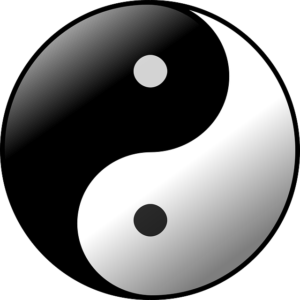
So Tai Chi is a martial art that focuses on the Yin and Yang qualities of energy.
Qigong on the other hand translates as energy work, or energy skill. Quite simply, it is any practice that allows us to work with our energy, or develop skill with our energy (or qi).
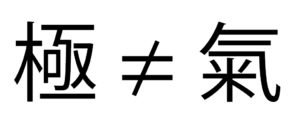
*An important disambiguation. Because of the complexities of the Chinese language, and the further complication of multiple systems of anglicization being used, sometimes people think the ‘Chi’ in Tai Chi, and the ‘Chi’ in Chi Kung are referring to the same thing. The Pinyin system makes this clearer with one being rendered ‘Ji’, and the other ‘Qi’. The Chi or Ji in Tai Chi refers to poles, while the Chi or Qi in Qigong refers to energy.
Relationship between Tai Chi and Qigong
So there is an overlap between Tai Chi and Qigong. They both have a focus on working with energy and the qualities of energy. Tai Chi specifically in the context of a martial art, and qigong more broadly to every area of life. If you were to draw venn diagrams of these two arts they may look something like this:
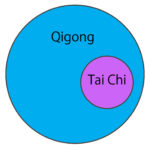
Or perhaps like this:
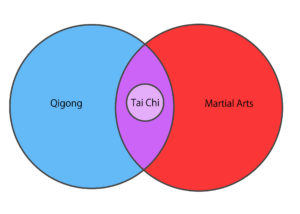
There are lots of different things that you could put into the diagrams, and some people may quibble about the exact specifics of where you place some of the circles, but the main point is that Tai Chi is in fact a type of Qigong. They are not really different, Qigong is just a broad term referring to all of the energy practices, while Tai Chi is referring to a specific style and application of qigong principles within a practice.
In practical terms, this is going to mean that they are often going to look quite similar. You are often going to see slow movements, a focus on breathing, balanced posture, and so on. They are both seeking to work with energy, its just that sometimes the intention of how that energy is used will be different.
History and origins of Tai Chi and Qigong
The names Tai Chi and Qigong have actually both only come into common usage relatively recently in the 19th and 20th centuries respectively, but both refer to practices dating back well before this time. There is archaeological evidence of qigong practice on pieces of pottery and ancient drawings dating back to between 5000 and 8000 years. Because its origins are so ancient, there is no single historical figure that can be pointed to as the creator or qigong. There are some who are famous for their contributions, such as the Yellow emperor with his work on medicine, Damo or Bodhidharma who introduced qigong to the Shaolin monks as a way to help them stay focused on their spiritual practice of meditation, and General Yeu Fei who developed a set of 12 qigong exercises for his soldiers as a way to keep them healthy and strong and fit for the rigours of military life and battle. Rather qigong is a collection of principles and practices which has had many contributors over many millenia.
Tai Chi on the other hand has a clear traceable history dating back between 400 and 900 years depending on how you read it, from Yang Luchan in the 1800s to Chen Wangting in the 17th century, and then further back to the Daoist monk Zhang Sanfeng in the 12th century, although some authors suggest that the connection to Zhang Sanfeng may be spurious. It is at this point that the two histories come together, because surely even in its earliest forms Tai Chi did not spring forth out of a vacuum, but rather would have been based on using known principles of working with energy, and applying them to their specific purpose for use within a martial art.
Benefits of Tai Chi
The martial art Tai Chi Chuan, focuses on creating harmony between Yin and Yang, and using the interplay between these two poles of energy to allow the energy to flow freely through the practitioner’s body. There is great emphasis put on the smooth shifting of weight, from full (yin) to empty (yang). It uses very slow movements as a way to make these changes and transitions clear. This is challenging for the muscles and proprioception, and a great way to build strength, particularly in the legs, and improve balance. The large flowing movements with the arms and body encourage increased range of motion and improved circulation of blood and other fluids through the body. The slowness of the practice, combined with deep breathing, helps to clear the mind and develop focus. Sounds pretty good right?! And all while practicing the ‘Supreme Ultimate’ martial art – so you can gain self defense benefits at the same time. Of course for self defense application, the movements will be sped up – considerably… ????
Benefits of Qigong
Qigong uses all of these same principles, and many more. Its scope is open to all the ways that it is possible to work with and develop skill with directing energy. For this reason we find a much greater diversity of practices in qigong, and specific practices focused on delivering many different benefits. For example in the area of health you will find qigong exercises for the liver, or the heart, or other specific organs. You will find practices for working with and clearing specific emotions. You will find practices that can be done standing, sitting, and even lying down. You will find practices that connect you to the energy of nature, and practices that help you to express your energy in creative pursuits more effectively.
Energy is a part of every aspect of our lives, and so with enough searching, you can find a qigong practice that will apply specifically to what you are interested and want to work on.
Modern usage
These mind/body, health and wellness benefits of Tai Chi are so great, and have become so well known, that many, in fact I would say probably the vast majority of Tai Chi practitioners in the western world practice it primarily, or solely as a health practice. In fact many Tai Chi students, and even teachers are unaware that what they are doing is a martial art – it is purely the health and mindfulness benefits that they are aware of and interested in. Really they are practicing it as a form of qigong for health rather than as a martial art. In fact, because so many practitioners are purely interested in health benefits, and because the name ‘Tai Chi’ is more widely recognised than ‘Qigong’ it is not uncommon to find other types of Qigong being taught as Tai Chi – even though there is clearly no Chuan involved.
It is possible to find practitioners and teachers training Tai Chi as a martial art, but you have to look pretty hard, and because this has not been the primary focus for so many practitioners for so long, it is very difficult to find good quality instruction in this area. I have seen even very famous Tai Chi teachers when questioned on the purpose of different movements, fumble and stumble, and demonstrate that they clearly do not understand the fighting application of the movements they teach. On the other hand I have met and trained with a very few teachers that still understand the martial aspect of their art, but they are few and far between.
While qigong in theory can be applied to every aspect of life, the vast majority of what you will find is simply focused on health and wellbeing. In this way there is great similarity between the modern practice of both Tai Chi and Qigong. It turns out that what most people are interested in is health. I think that’s great! You can find Qigong practices for other applications being taught, including for self defense outside the specific context of Tai Chi (often within other Kung Fu styles), but again, you will usually need to look a lot harder to find them.
Which one is right for you?
So which of these arts is right for you? The answer is likely to come down to some broad stylistic differences between how they are commonly practiced, and how specific your objectives are for what you hope to achieve with your practice.
If your interest is general health and wellbeing, then either Tai Chi or Qigong may suit your purposes very well. In terms of stylistic difference, you will find that Tai Chi usually involves learning quite long choreographed sequences of movements, and refining every last detail of them. It can be a long journey of discovery as the specific nature of each movement gradually unfolds. Many practitioners find that the intrigue and challenge of this process helps to keep them engaged and focused on their practice over a long period of time.
While qigong can sometimes include long sequences of movements, what is more common is individual movements, or short series of relatively more simple movements focused on specific benefits. In general these are easier to learn and get ‘right’. There are also more options of practices for different positions, such as sitting or lying down, compared to Tai Chi which is almost always done standing up.
If you have some more specific goals for your practice, that are not martial in nature, it is more likely that you will find the tools that you need within the broad field of qigong than the more specific practice of Tai Chi. For example if you are looking for help with a specific health problem, you are more likely to find specific exercises that help with that within qigong, than the more general health benefit you may gain from Tai Chi. For other objectives, with Qigong’s broader focus on understanding energy and application of skill with it, even if you cannot find practices that specifically focus on the areas you are interested in, you will be able to learn principles that you can apply in your own way to achieve your objectives.
And of course – in the end, this does not need to be an either or choice. There is no reason why you cannot practice Tai Chi and other more specific qigong practices as well. In fact it is common in Tai Chi classes to practice some other types of qigong at the start of the class, to help balance the energy, and get it flowing freely or in a particular way, before moving into the practice of the specific Tai Chi movements. Practicing Qigong in this way can greatly enrich your Tai Chi practice, bringing a greater awareness of energy and flow to this already energy filled practice.
Conclusion
I hope you have enjoyed this article on the differences between Tai Chi and Qigong, and that it has helped you to understand the similarities and crossover between these two arts. If you are interested in delving deeper into qigong and its many practices and applications, Long White Cloud Qigong has several online courses that make a good place to start. We also write frequent articles and record vlogs that explore many interesting details of the philosophy, practice, and application of qigong. If you are interested in this, make sure you subscribe to our email newsletter below.
4 Comments. Leave new
I have never been attracted to Tai Chi but for many years now I cannot live without Qigong. Thank you for the history. I had no idea that Qigong could be nearly 8000 years old. But it makes sense. Very informative and enlightening article. Thank you.
Thanks for the comparisons! This question came up just last week and I was glad to have this background info.
Couldn’t quan also represent toil or work or even ren?
Not in the context of Taijiquan – it is specifically referring to its martial nature.